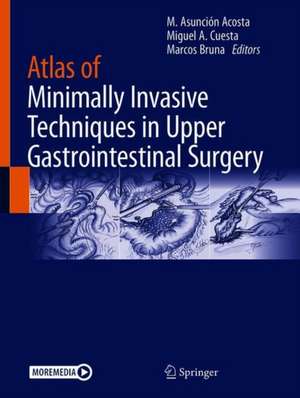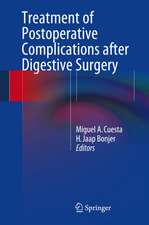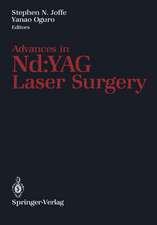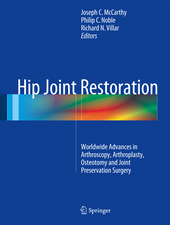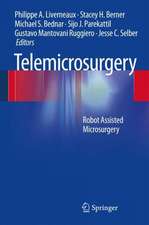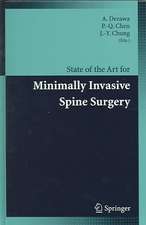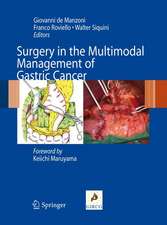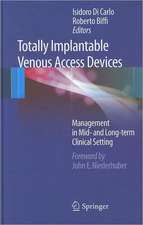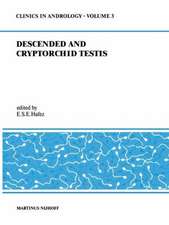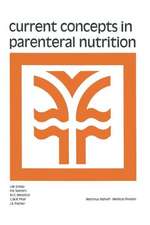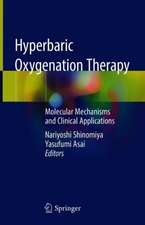Atlas of Minimally Invasive Techniques in Upper Gastrointestinal Surgery
Editat de M. Asunción Acosta, Miguel A. Cuesta, Marcos Brunaen Limba Engleză Hardback – 4 mar 2021
This Atlas comprehensively covers minimally invasive operative techniques for benign and malignant cancer surgery of the esophagus and stomach. It provides easy-to-follow instructions accompanied by a range of pictures and illustrations, as well as a collection of interactive videos to aid the reader in developing a deeper understanding of each surgical procedure. Techniques covered include minimally invasive surgical treatment for esophageal and gastric cancer including different approaches such as thoracoscopic, transhiatal, laparoscopic, and robot-assisted resections. These chapters include different types of cervical and intrathoracic anastomoses after esophageal resections, and different anastomoses and reconstructions after gastrectomy. Moreover, the Atlas includes an extensive description of minimally invasive procedures in bariatric surgery including sleeve resection, gastric bypass, biliopancreatic diversion, and others. Minimally invasive approaches for other benign pathologies such as benign tumors and treatment of gastroduodenal ulcer complications are also depicted. All chapters, written by a renowned and experienced international group of surgeons and their teams, are focused on practical step-by-step description of the techniques.
Atlas of Minimally Invasive Techniques in Upper Gastrointestinal Surgery systematically describes the most frequently performed surgical procedures of the esophagus and stomach and is a valuable resource for all practicing surgeons and trainee general surgeons dedicated to upper gastrointestinal surgery, such as bariatric and surgical oncologists.
Atlas of Minimally Invasive Techniques in Upper Gastrointestinal Surgery systematically describes the most frequently performed surgical procedures of the esophagus and stomach and is a valuable resource for all practicing surgeons and trainee general surgeons dedicated to upper gastrointestinal surgery, such as bariatric and surgical oncologists.
| Toate formatele și edițiile | Preț | Express |
|---|---|---|
| Paperback (1) | 1305.12 lei 6-8 săpt. | |
| Springer International Publishing – 5 mar 2022 | 1305.12 lei 6-8 săpt. | |
| Hardback (1) | 1638.65 lei 38-44 zile | |
| Springer International Publishing – 4 mar 2021 | 1638.65 lei 38-44 zile |
Preț: 1638.65 lei
Preț vechi: 1724.90 lei
-5% Nou
Puncte Express: 2458
Preț estimativ în valută:
313.60€ • 326.19$ • 258.89£
313.60€ • 326.19$ • 258.89£
Carte tipărită la comandă
Livrare economică 10-16 aprilie
Preluare comenzi: 021 569.72.76
Specificații
ISBN-13: 9783030551759
ISBN-10: 303055175X
Pagini: 369
Ilustrații: XVI, 369 p. 655 illus., 649 illus. in color.
Dimensiuni: 210 x 279 mm
Greutate: 1.35 kg
Ediția:1st ed. 2021
Editura: Springer International Publishing
Colecția Springer
Locul publicării:Cham, Switzerland
ISBN-10: 303055175X
Pagini: 369
Ilustrații: XVI, 369 p. 655 illus., 649 illus. in color.
Dimensiuni: 210 x 279 mm
Greutate: 1.35 kg
Ediția:1st ed. 2021
Editura: Springer International Publishing
Colecția Springer
Locul publicării:Cham, Switzerland
Cuprins
Contents.- Surgical Anatomy of the Esophagus.- A Concentric-Structured Model for the Understanding of the Surgical Anatomy in the Upper Mediastinum Required for Esophagectomy with Radical Mediastinal Lymph Node Dissection.- A Surgical Concept for the Subcarinal Anatomy of the Esophagus and Mediastinum.- 270 Degrees Fundoplication for Gastroesophageal Reflux Esophagitis.- Laparoscopic Nissen Fundoplication.- Minimally Invasive Surgery of Paraesophageal Hernias.- Minimally Invasive Treatment of Esophageal Leiomyoma.- Peroral Endoscopic Myotomy (POEM) for Achalasia.- Endoscopic Treatment of Early Esophageal Cancer.- Transmediastinal Approach for Esophageal Cancer: Upper and Middle Mediastinal Dissection with Single Port Technique.- Laparoscopic Transhiatal Resection for Distal Esophageal and Gastro-Esophageal Junction Cancer.- Robot Assisted-Minimally Invasive Transhiatal Esophagectomy.- Minimally Invasive Esophagectomy: Ivor-Lewis.- Thoracoscopic Radical Esophagectomy for Cancer.- Three-Stage McKeown Minimally Invasive Esophagectomy Procedure in Prone Position.- Robot-assisted Minimally Invasive Esophagectomy (RAMIE).- Cervical Esophagogastric Anastomosis.- Intrathoracic Esophago-gastrostomy After MIE Ivor Lewis Resection: End-to-side Anastomosis by Means of Circular Stapler (The Flap and Wrap Technique).- Intrathoracic Esophago-gastrostomy After MIE Ivor Lewis Resection: Side-to-side Anastomosis by Means of a Linear Stapler.- Intrathoracic esophago-gastrostomy After MIE Ivor Lewis Resection: End-to-side Anastomosis by Means of a Circular Stapler and Endoloop.- Intrathoracic Esophago-gastrostomy After MIE Ivor Lewis Resection: End-to-side Anastomosis Using a Double Endoloop System.- Intrathoracic Esophago-gastrostomy After MIE Ivor Lewis Resection: End-to-side Handsewn Anastomosis.- Intrathoracic Robot-Assisted Minimally Invasive Esophagectomy (RAMIE) Ivor Lewis End-to-side Anastomosis.- Surgical Anatomy of the Stomach and the Omental Bursa.- Minimally Invasive Treatment of Gastric GIST.- Minimally Invasive Surgery for Treatment of Complications of Gastroduodenal Ulcer.- Laparoscopic Adjustable Gastric Band.- Laparoscopic Roux en Y Gastric Bypass.- Laparoscopic Sleeve Gastrectomy.- Laparoscopic Duodenal Switch.- Single Anastomosis Duodenoileal Bypass with Sleeve Gastrectomy.- Endoscopic and Minimally Invasive Surgical Treatment of Early Gastric Cancer.- Laparoscopic Partial Gastrectomy for Gastric Cancer.- Modified Billroth-I Delta-shaped Anastomosis After Distal Gastrectomy.- Robotic Distal Gastrectomy for Gastric Cancer.- Laparoscopic Total Gastrectomy for Gastric Cancer.- Spleen-preserving Splenic Hilar Dissection for Proximal Gastric Cancer.- End-to-side Esophago-jejunal Anastomosis Using the Circular Orvil Device.- Handsewn Anastomosis After 95% Gastrectomy, Total Gastrectomy and Total Gastrectomy Extended to the Distal Esophagus for Gastric Cancer.- Robot-assisted Total Gastrectomy for Gastric Cancer.- Laparoscopic Immunofluorescence-guided Lymphadenectomy in Gastric Cancer Surgery.- Final Considerations.
Notă biografică
María Asunción Acosta-Mérida is Head of the Department of Esophagogastric, Endocrinometabolic, and Obesity Surgery at the University Hospital of Gran Canaria, Dr. Negrín, an expert in bariatric surgery, and a member of the multiple organ–harvesting team at her hospital. She is also a Professor of Digestive Surgery at the University of Las Palmas de Gran Canaria and a member of the Board of Esophagogastric and Minimally Invasive Surgery of the Spanish Association of Surgeons, as well as the Spanish Society for Obesity Surgery. M. Asunción also directs several national courses on bariatric and esophagogastric surgery and has authored scientific publications on various aspects of gastrointestinal surgery.
Miguel A. Cuesta is Professor Emeritus of Gastrointestinal and Minimally Invasive Surgery at the Amsterdam UMC, in Amsterdam, the Netherlands. After his publication as editor in 1993 of the book Minimally Invasive Surgery in Gastrointestinal Cancer, considered a pioneer work in the use of minimally invasive surgery (MIS) in oncological surgery, he has focused on researching the use of MIS in digestive oncology. He has participated and initiated different randomized controlled trials concerning colorectal and upper GI surgery comparing open and MIS approaches.
Marcos Bruna currently works as a surgeon in the Department of General and Digestive Surgery at the Hospital Universitario de Valencia y Politécnico La Fe (Spain). His research primarily involves Gastroenterology, Hepatology, and Nutrition and Dietetics. He is specialized in upper GI surgery, both oncological and bariatric, and has participated in research concerning minimally invasive surgery, bariatric, and metabolic surgery. Moreover, he is currently involved in studies on enhanced recovery after surgery for esophagogastric cancer
Miguel A. Cuesta is Professor Emeritus of Gastrointestinal and Minimally Invasive Surgery at the Amsterdam UMC, in Amsterdam, the Netherlands. After his publication as editor in 1993 of the book Minimally Invasive Surgery in Gastrointestinal Cancer, considered a pioneer work in the use of minimally invasive surgery (MIS) in oncological surgery, he has focused on researching the use of MIS in digestive oncology. He has participated and initiated different randomized controlled trials concerning colorectal and upper GI surgery comparing open and MIS approaches.
Marcos Bruna currently works as a surgeon in the Department of General and Digestive Surgery at the Hospital Universitario de Valencia y Politécnico La Fe (Spain). His research primarily involves Gastroenterology, Hepatology, and Nutrition and Dietetics. He is specialized in upper GI surgery, both oncological and bariatric, and has participated in research concerning minimally invasive surgery, bariatric, and metabolic surgery. Moreover, he is currently involved in studies on enhanced recovery after surgery for esophagogastric cancer
Textul de pe ultima copertă
This Atlas comprehensively covers minimally invasive operative techniques for benign and malignant cancer surgery of the esophagus and stomach. It provides easy-to-follow instructions accompanied by a range of pictures and illustrations, as well as a collection of interactive videos to aid the reader in developing a deeper understanding of each surgical procedure. Techniques covered include minimally invasive surgical treatment for esophageal and gastric cancer including different approaches such as thoracoscopic, transhiatal, laparoscopic, and robot-assisted resections. These chapters include different types of cervical and intrathoracic anastomoses after esophageal resections, and different anastomoses and reconstructions after gastrectomy. Moreover, the Atlas includes an extensive description of minimally invasive procedures in bariatric surgery including sleeve resection, gastric bypass, biliopancreatic diversion, and others. Minimally invasive approaches for other benign pathologies such as benign tumors and treatment of gastroduodenal ulcer complications are also depicted. All chapters, written by a renowned and experienced international group of surgeons and their teams, are focused on practical step-by-step description of the techniques.
Atlas of Minimally Invasive Techniques in Upper Gastrointestinal Surgery systematically describes the most frequently performed surgical procedures of the esophagus and stomach and is a valuable resource for all practicing surgeons and trainee general surgeons dedicated to upper gastrointestinal surgery, such as bariatric and surgical oncologists.
Atlas of Minimally Invasive Techniques in Upper Gastrointestinal Surgery systematically describes the most frequently performed surgical procedures of the esophagus and stomach and is a valuable resource for all practicing surgeons and trainee general surgeons dedicated to upper gastrointestinal surgery, such as bariatric and surgical oncologists.
Caracteristici
Comprehensively covers minimally invasive surgery of the esophagus and stomach
Provides step-by-step descriptions of the most frequently performed minimally invasive procedures of the esophagus and stomach, including oncological and bariatric procedures
Contains up-to-date guidance on how to successfully perform minimally invasive procedures of the esophagus and stomach
Provides step-by-step descriptions of the most frequently performed minimally invasive procedures of the esophagus and stomach, including oncological and bariatric procedures
Contains up-to-date guidance on how to successfully perform minimally invasive procedures of the esophagus and stomach
